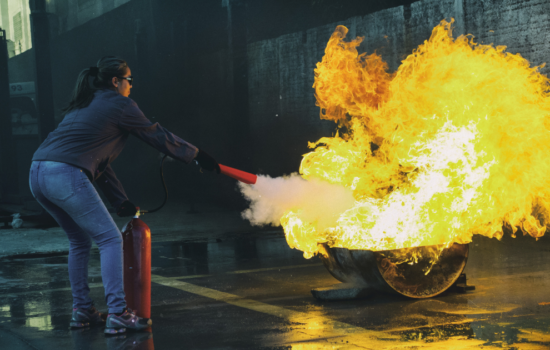
Fire safety is a critical aspect of workplace health and safety, and one of the most effective ways to ensure that your business is prepared for a fire emergency is through comprehensive fire and safety training. In New Zealand, businesses are increasingly recognising the importance of this training as part of their overall safety protocols. But what exactly does training involve, and why is it essential for your business? This article will explore the key components of fire safety training and its benefits.
So, What Is Fire and Safety Training?
Fire and safety training is a structured program designed to educate employees about fire prevention, emergency response, and evacuation procedures. This training equips your team with the knowledge and skills they need to act quickly and effectively in the event of a fire, minimising risks to life and property.
In New Zealand, training is not just a best practice; for many businesses, it’s a legal requirement under the Fire and Emergency New Zealand (FENZ) Act 2017. Whether you run a small office or a large industrial facility, providing fire safety training can help ensure compliance with safety regulations and enhance overall workplace safety.
Key Components of Fire and Safety Training
A comprehensive fire safety training program typically covers several key areas:
1. Fire Prevention
The best way to deal with a fire is to prevent it from happening in the first place. Fire safety training educates employees on identifying potential fire hazards in the workplace, such as faulty electrical equipment, improper storage of flammable materials, and poor housekeeping practices. By understanding these risks, employees can take proactive steps to reduce the likelihood of a fire starting.
2. Emergency Response Procedures
In the event of a fire, knowing how to respond quickly and correctly is crucial. Fire safety training includes instruction on emergency response procedures, such as raising the alarm, using fire extinguishers, and assisting others in evacuating the building. Employees learn the importance of staying calm and following the established protocols to ensure a safe and orderly evacuation.
3. Evacuation Drills
Evacuation drills are an essential part of fire safety training. These drills simulate a real fire emergency, allowing employees to practise evacuating the building and reaching designated assembly points. Regular drills help reinforce the training and ensure that everyone knows what to do and where to go in an emergency.
4. Use of Fire Safety Equipment
Training also includes hands-on instruction on using fire safety equipment, such as fire extinguishers, fire blankets, and alarm systems. Employees learn which types of extinguishers to use for different types of fires (e.g., electrical, chemical, or grease fires) and how to operate them effectively.
5. Understanding Fire Safety Signage
Fire safety signs are crucial for guiding people during an emergency. Training covers the different types of fire safety signage, including exit signs, fire extinguisher locations, and assembly point markers. Understanding these signs ensures that employees can navigate safely and efficiently during an evacuation.
6. Roles and Responsibilities
In larger businesses, certain employees may be designated as fire wardens or safety officers. Fire safety training includes specific instruction for these roles, such as overseeing the evacuation process, conducting headcounts, and liaising with emergency services. Clear roles and responsibilities help ensure that the evacuation process is well-coordinated and effective.
Why Is it Essential?
There are several reasons why fire safety training is essential for businesses in New Zealand:
1. Protecting Lives
The primary goal of fire safety training is to protect the lives of employees, customers, and visitors. By equipping your team with the knowledge and skills to respond effectively to a fire, you can significantly reduce the risk of injury or loss of life.
2. Minimising Property Damage
A well-trained workforce can take quick action to control a small fire before it spreads, potentially saving your business from extensive property damage. Knowing how to use fire extinguishers correctly and when to evacuate can make a significant difference in minimising fire damage.
3. Ensuring Compliance
In New Zealand, businesses must comply with fire safety regulations, which often include requirements for fire safety training. Failure to meet these requirements can result in fines, legal action, and increased insurance premiums. Regular training helps ensure that your business meets all legal obligations.
4. Promoting a Safety Culture
Fire safety training promotes a culture of safety within your organisation. When employees understand the importance of fire safety and know how to respond in an emergency, they are more likely to take safety seriously in other aspects of their work as well. This can lead to a safer, more responsible workplace overall.
How Often Should Fire and Safety Training Be Conducted?
The frequency of fire safety training depends on several factors, including the size and nature of your business. However, it’s generally recommended that fire safety training be conducted at least annually, with additional sessions for new employees or when significant changes occur in the workplace, such as renovations or the introduction of new equipment.
Regular training ensures that the information remains fresh in employees’ minds and that everyone is up-to-date with the latest safety protocols.
Fire and safety training is a vital investment in the safety and well-being of your employees and your business. By providing comprehensive training on fire prevention, emergency response, and the proper use of fire safety equipment, you can create a safer workplace and ensure compliance with New Zealand’s fire safety regulations.
Whether your business operates in a low-risk office environment or a high-risk industrial setting, fire safety training is essential to protecting lives and property. Partnering with a fire protection specialist can help you develop and deliver an effective training program tailored to your specific needs.



